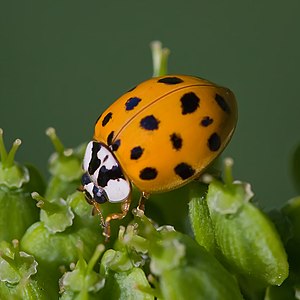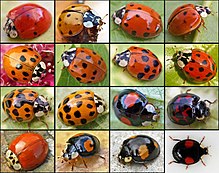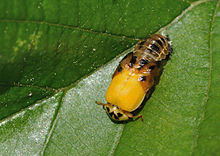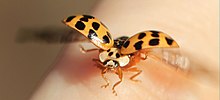Asian ladybug
| Asian ladybug | ||||||||||||
|---|---|---|---|---|---|---|---|---|---|---|---|---|

Asiatic ladybird ( Harmonia axyridis ) |
||||||||||||
| Systematics | ||||||||||||
|
||||||||||||
| Scientific name | ||||||||||||
| Harmonia axyridis | ||||||||||||
| ( Pallas , 1771) |

The Asian ladybird ( Harmonia axyridis , also " multi-colored " or " Harlequin ladybird ") is a beetle from the ladybird family (Coccinellidae).
The species originally comes from Asia and was first introduced to the USA at the end of the 20th century and then to Europe for biological pest control . It is now occurring en masse in many places, and it is feared that it will displace native ladybird species and other species as well. The beetle can be a nuisance to property owners, as it forms large swarms in autumn that go to houses and other sheltered places to hibernate.
features
The beetles reach a body length of six to eight millimeters and are five to seven millimeters wide. They are extremely variable in color. The color of the wings varies between light yellow and dark red, while the black spots, of which the beetles usually have 19, can be so pronounced that it appears as if a black beetle has red spots, for example. The black points can also be weak or completely absent. The pronotum is light yellowish and is characterized in the middle by a black "M" or "W" -shaped drawing. This feature can be so pronounced that the entire middle part of the pronotum is black and only the sides are brightly colored.
The larvae have a black to blue-gray basic color and carry more or less long bristles with two or three branches (scoli) all over their bodies. The abdomen is colored orange on the first five segments on both sides of the back, including the bristles located there. In addition, on the fourth and fifth abdominal segments, closer to the back, there is another orange-colored bristle on each side. Very young larvae are initially yellow-green in color and have black bristles, later the body color becomes dark and the orange areas develop.
The Asian ladybird is less susceptible to disease than the Central European species; firstly through the number and variety of peptides to ward off infection and secondly through an antimicrobial substance called harmonin . Its hemolymph also contains small spores of a parasitic unicellular organism . These so-called microsporidia penetrate the cells of their host and multiply there. If other ladybugs eat the larvae or eggs of an infected beetle, they can also become infected with microsporidia. The consequence of the parasite infestation is serious illness or even death - but only for the native ladybug species. In contrast, for reasons that are still unknown, the parasite in the Asian ladybird seems to be inactive and does not harm it, although it can be found in all stages and even in its eggs. Due to their disease resistance and with the help of the microsporidia, which they use as a biological weapon, the invasive beetles from East Asia gain a considerable selection advantage , so that they succeed in displacing the native ladybird species more and more.
distribution
The natural range of the Asian ladybird is in Eastern Asia. It occurs in China, south to Yunnan and Guangxi , in Japan, Korea, Mongolia and in eastern Russia, here from Novosibirsk Oblast and the Krasnoyarsk Region in southern Siberia via the Altai to the Amur Oblast and Primorye region on the Pacific Ocean . The species has been used successfully in many areas for biological pest control since 1916. In numerous regions, animals have either escaped from crops and greenhouses, or they have been released in the open in a more or less uncontrolled manner. The beetle has spread almost worldwide.
Introduction by humans
In the USA it was already used for pest control at the beginning of the 20th century (documented since 1916); further exposures have become known in at least 14 cases from 1964 to 1982. The populations did not establish themselves initially. The first documented naturalization in the wild was reported in Louisiana in 1988. In 1994 it was already established in 24 states, on the Atlantic and Pacific coasts, and is expanding rapidly. The first evidence from Canada dates back to 1994. In Mexico, it spread through independent releases and is now widespread. The first release in South America, for biological pest control, was in Mendoza , Argentina in 1986 . The species has been spreading here since the early 2000s, for example in Brazil since 2002, where it is already widespread in the southeast. In South Africa, it was introduced, presumably unintentionally, into the Western Cape from 2001 , and it now occurs throughout the country. Evidence from Kenya has been available since 2010, further evidence is available from Egypt and Tunisia. An import has been registered several times in Australia, but so far it has been possible to prevent settlement.
Like other species of ladybirds, it inhabits a variety of habitats where aphids are found, but appears to be particularly common near cities.
The first free-living specimen of the Asian ladybird in Europe was found in Belgium in 2001 , after it had been used and marketed for pest control in Ukraine in 1964 and in France since 1982. Since then, the species has spread rapidly. Since 2002 it has been sighted partially en masse in West Germany and since 2004 it can be found in parts of France and the south of Great Britain. The exact distribution limits are not known, but the beetle now seems to be found all over Germany . It has also spread widely in Switzerland. The first specimen living in the wild was found there in 2004 in Basel. Since then the species has spread massively. In 2006, eleven cantons were affected and the first autumn swarms were spotted. Just one year later, the species was found practically in all of Switzerland and in autumn formed collections of several hundred specimens. The beetle has also been documented from Austria since 2006 and is now found there in all federal states. Today's European distribution ranges from Norway, Sweden, Scotland and Ireland in the north to Spain, Italy and Greece in the south.
Way of life and development
The Asian ladybird eats large quantities of aphids . It can eat 100 to 270 aphids per day. However, it also does not disdain other soft-shelled insects, insect eggs and larvae. Like other species of the same genus, the larvae of the Asian ladybird also eat eggs, larvae and pupae of their own and other ladybird species . Problematic for domestic species the presence of parasites in the entrained species is ( so ). Ladybugs do not reproduce or feed during the winter. In this respect, they pose no threat to buildings. It has few natural enemies because, like most ladybird species , it can secrete its yellow, bitter-tasting and poisonous hemolymph if there is danger from reflex bleeding . The female lays her eggs on aphid-infested plants. The larvae hatch after three to five days and take two weeks to develop. During this time a single larva can eat up to 1200 lice. After the larva has pupated on a leaf, it takes five to six days for the imago to hatch.
Asian ladybug and wine
The ladybird poses a particular problem for the wine industry. Especially at the time of the grape harvest, ladybirds spend the night in the area of the grapes, which is relatively protected from the weather. If the ladybirds get into the processing of the grapes in the course of the grape harvest, their hemolymph goes into the mash or must. This can lead to a considerable loss of wine quality. Affected wines are characterized in the sensor system with descriptions such as "bitter, paprika, peanut butter, asparagus". The substance 2-isopropyl-3-methoxypyrazine (IPMP) has meanwhile been identified as the main odor component that originates from the ladybird's hemolymph .
Web links
- Agency for Health and Food Safety (AGES) Vienna, ages.at: Asiatic ladybird
- RL Koch: The multicolored Asian lady beetle, Harmonia axyridis: A review of its biology, uses in biological control, and non-target impacts. In: Journal of insect science. Volume 3, 2003, p. 32, doi : 10.1093 / jis / 3.1.32 , PMID 15841248 , PMC 524671 (free full text) (review).
Individual evidence
- ↑ Deutschlandfunk: Asiatic ladybirds. Invasion of the Harlequin by Volker Mrasek. Research Current, February 26, 2018.
- ↑ [1] Asian ladybirds use bio-weapons against their European relatives - invasive beetles from East Asia displace native ladybird species with the help of microsporidia
- ↑ A. Vilcinskas, K. Stoecker et al. a .: Invasive Harlequin Ladybird Carries Biological Weapons Against Native Competitors. In: Science. 340, 2013, pp. 862-863, doi : 10.1126 / science.1234032 .
- ↑ a b c d Peter MJ Brown, Cathleen E. Thomas, Eric Lombaert, Daniel L. Jeffries, Arnaud Estoup, Lori-Jayne Lawson Handley (2011): The global spread of Harmonia axyridis (Coleoptera: Coccinellidae): distribution, dispersal and routes of invasion. BioControl 56: 623-641. doi: 10.1007 / s10526-011-9379-1
- ↑ a b Tim Adriaens, Gilles San Martin y Gomez, Dirk Maes: Invasion history, habitat preferences and phenology of the invasive ladybird Harmonia axyridis in Belgium. From biological control to invasion: the Ladybird Harmonia axyridis as a model species. Springer Netherlands, 2008. pp. 69-88.
- ↑ a b Ladybug infestation in the house: what to do? Research station Agroscope Reckenholz-Tänikon ART, media release of October 10, 2008 (PDF)
- ↑ Asiatic ladybug. Harmonia axyridis AGES - Austrian Agency for Health and Food Safety, last changed: June 5, 2019
- ↑ Hildegard Kaulen: The cannibals among the beetles live risky. In: Frankfurter Allgemeine Zeitung. May 27, 2013, accessed April 22, 2016 .
- ↑ Deutsche Welle World: Project Future: Biokiller - the secret of the Asian ladybird by Volker Mrasek. Research Current, February 26, 2018
- ↑ a b Saxony nature: Asiatic ladybird, Harmonia axyridis
- ↑ GJ Pickering, A. Karthik, D. Inglis, M. Sears, K. Ker: Determination of Ortho- and Retronasal Detection Thresholds for 2-Isopropyl-3-Methoxypyrazine in Wine . Journal of Food Science 72, pp. 468-472, September 2007 doi : 10.1111 / j.1750-3841.2007.00439.x
- ^ GJ Pickering, JY Lin, R. Riesen, A. Reynolds, I. Brindle and G. Soleas: Influence of Harmonia axyridis on the Sensory Properties of White and Red Wine . American Journal for Enology and Viticulture, 55, 2, pp. 153–159, 2004 Abstract (English)



